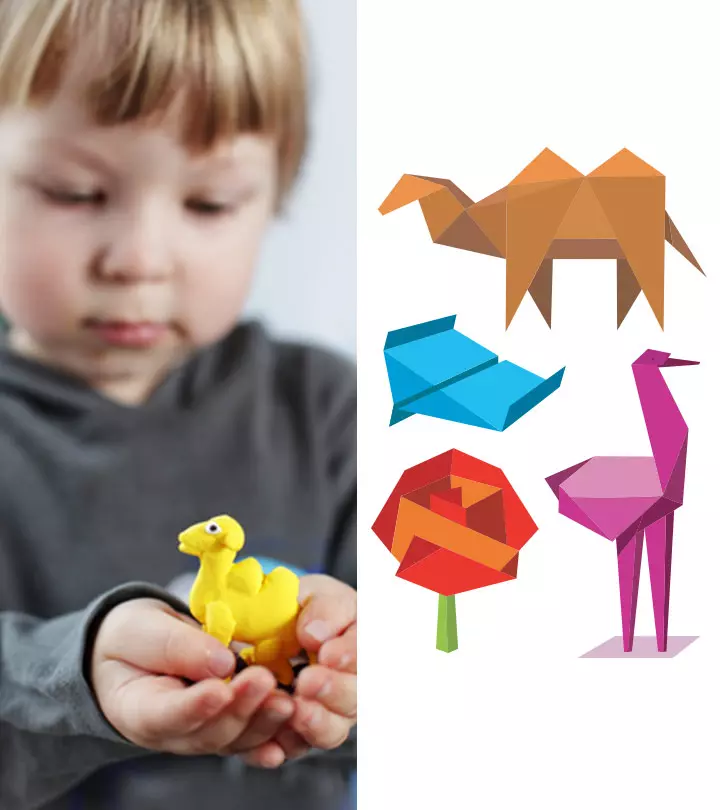

Image: Shutterstock
Every child should have a sufficient sleep as per their age. But, many children have difficulty falling and staying asleep throughout the night. Sleep meditation for kids is one technique that might provide relaxation to the child so that they have an undisturbed, peaceful night’s sleep.
Sleep meditation can help manage overstimulation. Overstimulation before bedtime could make it difficult for children to fall asleep. Some children may even refuse to sleep and start throwing tantrums during bedtime. In such scenarios, parents may consider trying sleep meditation to instill a sense of calmness before the child goes to bed.
In this post, you may discover more about introducing sleep meditation and its benefits for children.
What Is Meditation Sleep For Kids?
Adults extensively employ meditation after a hectic day to relax and drift off. Children can use the same techniques to relax their minds and fall asleep.
Meditation sleep is the technique where the child has to think positive thoughts or about soothing sensations so that their mind can relax from all the stimulation of the day. It helps lull the child to sleep.
As your child focuses on positive thoughts and pleasant sensations in their body while falling asleep, there is a good chance that they will sleep through the night, as well. Sleep meditation also helps create a safe environment for your child so that they can overcome bedtime fears and slowly unwind from overstimulation.
How To Introduce Kids To Meditation Sleep?
The most crucial aspect of any meditation is creating a proper environment. You cannot meditate and relax when your surroundings are noisy and chaotic (1).
Parents must create a safe and warm environment so that the child feels loved and secure during meditation. Here are some tips for introducing meditation to your child at bedtime.
1. Let your child be involved
Involve your child in the preparation of meditation. Let them choose their soft toys or a favorite blanket to keep with them while sleeping. They can also decide the color of the night light or even the pattern of their sheets. It can help make the child feel involved and make them eager to participate in meditation before sleep.
2. Let them choose the mode
Some children love songs, while others prefer stories during meditation. Ask them what they want to hear. If you have multiple children sleeping in one room, you can take turns in picking what each child likes every alternate night.
If you feel that the several options might disrupt the purpose of meditation, offer them a limited number of choices. This way, they feel they are in control while not getting overwhelmed by endless choices.
3. Let them choose the voice
Let your child choose the voice that soothes them the most. There are podcasts that help your child meditate before bedtime. Alternatively, some children prefer listening to stories in their parents’ voices. Some children might even prefer white noise to voices. Let them choose what they like according to their comfort levels.
4. Include a bedtime prayer
A bedtime prayer or saying a word of gratitude before the day ends teaches your children to look at the positive side of every situation. Every night, take turns in practicing gratitude. It helps your children remember that they are loved and cherished. This will reduce their stress levels and also increase the bonding between family members.
5. Give it time and patience
Some children might find it difficult to incorporate these new changes in their regular bedtime routine. They might resist this and even throw tantrums. However, you know that introducing meditation for kids’ sleep is the best thing you can do for them. So, you must persist with the activity gently.
If you punish them or force the meditation on them, the entire activity might have the opposite effect. Instead, speak gently to them and make them understand the value of meditation when they are in a relaxed frame of mind during the day.
Start with a few minutes of meditation in the beginning and extend the time gradually. Remember that this change will not happen in a day. You need to give it some time and patience to lead your children to a meditative state.
Benefits Of Meditation Sleep For Kids
Children assimilate a lot of information during the day and they need good sleep to help their brains organize and process all that information. Sleep meditation can make them sleep better, thus making their mind and body relax better.
Meditation sleep for kids could provide the following benefits (2).
- Relieves stress and tension
- Improves concentration throughout the day
- Calms the mind
- Helps a child sleep through the night
- Makes a child feel secure and loved
- Reduces night terrors and other anxieties
- Helps overcome sleep issues
- Improves immunity
Sleep Meditation Techniques For Kids
You can use various techniques to stimulate your child’s imagination and send them into a deep sleep. Here are some ideas that might help you guide your child towards meditation.
- Floating through the clouds: In this meditation technique, you can ask your child to imagine that their bodies are as light as a feather and that a breeze can now lift them. Let them imagine how it would be if they could float among the clouds. Let them make friends with a fluffy cloud and rest their head on it, and sleep right under the warm sun.
- Jelly sweet: Tell your child that they are a jelly, which is slowly melting in the warm sun. Describe the texture of the soft jelly— squishy and slowly melting on the floor. You can continue describing the melting of jelly until your child falls asleep.
- Sleepy cottage: Sleepy cottage is the perfect place for your child to sleep in. Ask them to imagine a warm cottage with a soft feather bed and pillows. Describe how the breeze comes through the windows gently, across the green grass fields, and blows your child’s hair. As the moon comes up on the sleepy cottage, the child slowly falls asleep.
- Wash off the bad day: If your child has had a bad day at school or with their friends, you can use this meditation technique to help them forget the day and sleep soundly. Start by talking about the problem and then ask them to imagine washing off the problems starting from their head to their toes and away. This is a great way to help them deal with disappointments and sleep well.
- The rocking boat: In this meditation technique, ask your child to imagine that they are with you on a boat while wrapped in a thick blanket. The boat is moving gently on the water and lulling your child to sleep. Use the sound of flowing water in the background for more effect.
Tips To Practice Effective Meditation Sleep For Kids
We have seen the benefits of using meditation to make your child sleep well. However, you must keep in mind certain tips to make this meditation session fruitful (3).
1. Stick to a routine
Children love routines. Create a bedtime routine and follow it daily, even if you do not feel up to it. A simple routine is Bath-Brush-Read-Bed. You can insert meditation anywhere in the routine. In some cases, meditating could be better than reading, so you can switch them. Make sure your child goes to bed at the same time each night. A significant change in this sleep routine could cause irregular sleep habits in children.
2. Keep stimulants away
Children are very easily stimulated or overstimulated. Make sure you do not offer any snacks or drinks with sugar or caffeine before or close to bedtime. Also, make sure that they do not start playing some energetic game when it is time to sleep. A stimulated or overstimulated child finds it very difficult to fall asleep even if they are tired.
3. Switch off gadgets
Take away all the gadgets from your child’s room. Gadgets can distract your child from falling asleep. The blue light emitted by various devices is known to disrupt the sleep cycle (4). Start by switching off the television at least an hour before bedtime and slowly put away your phones, tablets, and other gadgets so that your child can wind down to sleep.
4. Make the room cozy
Select warm colors to decorate your child’s bedroom. Everything in the room should be warm and inviting and planned to cause the least amount of stimulation. Keep a set of soft toys for your child to hold during sleep. You can also use dark curtains to block out the light or a dim night light if your child is afraid of the dark. Keep the windows closed to keep the bedroom quiet or use a white noise machine.
Frequently Asked Questions
1. At what age should kids meditate?
As per expert recommendations, you may introduce meditation to your children when they attain preschool age. Start with a couple of minutes of meditation, and you may gradually increase the time based on how they perform. However, adjust the timings as per your child’s age and routines (6). Make sure you are not forcing the child as they might not sit steadily for a longer duration.
2. How long can kids meditate?
As per the American Academy of Pediatrics, for preschoolers, you may begin by introducing meditation for a few minutes per day, children above five and until 13 can meditate for about five to ten minutes twice a day; whereas teenagers and adults can meditate for five to 45 minutes per day based on how they are doing (5).
Undisturbed, continuous sleep is essential for children’s optimal development. Sleep meditation for kids may help them relax and manage sleep-related issues such as difficulty falling asleep or sleeping throughout the night. Sleep meditations help initiate positive thoughts and emotions before sleeping and soothe the senses to relax all the stimulations of the day. Create a calm and soothing environment to introduce sleep meditation to children. Turning off the light, bedtime prayers, and other bedtime routines can also add to sleep meditation and improve outcomes.
Key Pointers
- Sleep meditation encourages children to have positive thoughts before going to bed, enabling them to sleep better.
- Involving children in the preparation of meditation, making them listen to a soothing voice, and including prayers are some ways to introduce sleep meditation.
- The technique benefits children in many ways, such as improving concentration, calming the mind, and making them feel loved.
- Sticking to a routine, switching off the gadgets, and making the rooms comfortable are some ways to make sleep meditation effective.
References
1. Child Insomnia and Sleep Problems, Help Guide
2. Rachel Dawkins, The Importance of Sleep for Kids; John Hopkins All Children’s Hospital
3. Danielle Pacheco and Dr. Nilong Vyas, Children and Sleep; Sleep Foundation
4. How Blue Light Affects Kids’ Sleep; Sleep Foundation
5. Just Breathe: The Importance of Meditation for Kids, Healthy Children; AAP
6. Meditation for Kids: The Basics and the Benefits; Cleveland Clinic
Community Experiences
Join the conversation and become a part of our nurturing community! Share your stories, experiences, and insights to connect with fellow parents.
Read full bio of Dr. Neha Bhave Salankar














